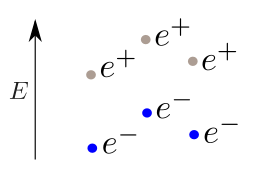Schwinger effect
The Schwinger effect is a predicted physical phenomenon whereby matter is created by a strong electric field. It is also referred to as the Sauter–Schwinger effect, Schwinger mechanism, or Schwinger pair production. It is a prediction of quantum electrodynamics (QED) in which electron-positron pairs are spontaneously created in the presence of an electric field, thereby causing the decay of the electric field. The effect was originally proposed by Fritz Sauter in 1931[1] and further important work was carried out by Werner Heisenberg and Hans Heinrich Euler in 1936[2], though it was not until 1951 when Julian Schwinger gave a complete theoretical description [3].

Mathematical description
Schwinger pair production in a constant electric field takes place at a constant rate per unit volume, commonly referred to as . The rate was first calculated by Schwinger[3] and at leading order in , the square of the charge of an electron, is equal to
where is the mass of an electron and is the electric field strength. This formula cannot be expanded in a Taylor series in , showing the nonperturbative nature of this effect. In terms of Feynman diagrams, one can derive the rate of Schwinger pair production by summing the infinite set of diagrams shown below, containing one electron loop and any number of external photon legs, each with zero energy.

Experimental prospects
The Schwinger effect has never been observed due to the extremely strong electric-field strengths required. Pair production takes place exponentially slowly when the electric field strength is much below the Schwinger limit, corresponding to approximately . With current and planned laser facilities, this is an unfeasibly strong electric-field strength, so various mechanisms have been proposed to speed up the process and thereby reduce the electric-field strength required for its observation.
The rate of pair production may be significantly increased in time-dependent electric fields [4][5][6], and as such is being pursued by high-intensity laser experiments such as the Extreme Light Infrastructure [7]. Another possibility is to include a highly charged nucleus which itself produces a strong electric field [8].
See also
References
- F. Sauter, "Über das Verhalten eines Elektrons im homogenen elektrischen Feld nach der relativistischen Theorie Diracs", Zeitschrift für Physik, 82 (1931) pp. 742–764. doi:10.1007/BF01339461
- W. Heisenberg and H. Euler, "Folgerungen aus der Diracschen Theorie des Positrons", Zeitschrift für Physik, 98 (1936) pp. 714-732. doi:10.1007/BF01343663 English translation
- J. Schwinger, "On Gauge Invariance and Vacuum Polarization", Phys. Rev.,82 (1951) pp. 664–679. doi:10.1103/PhysRev.82.664
- Brezin, E., and C. Itzykson. "Pair production in vacuum by an alternating field." Physical Review D 2(7) (1970) 1191doi:10.1103/PhysRevD.2.1191
- Ringwald, Andreas. "Pair production from vacuum at the focus of an X-ray free electron laser." Physics Letters B 510.1-4 (2001): 107-116.doi:10.1016/S0370-2693(01)00496-8
- Popov, Vladimir Stepanovich. "Schwinger mechanism of electron-positron pair production by the field of optical and X-ray lasers in vacuum." Journal of Experimental and Theoretical Physics Letters 74.3 (2001): 133-138.doi:10.1134/1.1410216
- I. C. E. Turcu; et al. (2016). "High field physics and QED experiments at ELI-NP" (PDF). Romanian Reports in Physics. 68: S145-S231.
- Müller, C.; Voitkiv, A. B.; Grün, N. (2003-06-24). "Differential rates for multiphoton pair production by an ultrarelativistic nucleus colliding with an intense laser beam". Physical Review A. American Physical Society (APS). 67 (6): 063407. doi:10.1103/physreva.67.063407. ISSN 1050-2947.